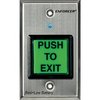Request-To-Exit Plates
What is Request-To-Exit Plate?
A Request-To-Exit plate or Push-To-Exit plate allows you to control the exit function of a door that uses electronic locking hardware. They are very commonly used in security and access control environments. An electronic lock is active and in lock mode when energized by power, the Request-To-Exit plate gives you the ability to de-energize the lock which would allow the door to be opened immediately. A Request-To-Exit plate offers a push-to-exit button or no touch sensor that triggers this unlocking function. It also clearly identifies itself by documenting its purpose right on the plate.
Where do I install a Request-To-Exit Plate?
Commonly, Request-To-Exit plates are installed on the wall directly inside the door. Since the plate is there to be pushed prior to opening the door, it is important to install it in a place where it is visible and easy for everyone to reach. Most Request-To-Exit plates are mounted directly on the wall next to the door or on the door frame. They are designed to be installed directly into a single gang low voltage mounting bracket, and wired directly to the electronic lock or the access system controller of the door.
How do I choose a Request-To-Exit Plate?
There are numerous Request-To-Exit plate products available to support not only your needs, but the look you want to achieve. Request-To-Exit plates are available with plastic mushroom buttons, illuminated buttons; all stain-less steal designs, single gang or slim-line designs, or with no touch sensors for use in areas where germs or cleanliness is a concern. Request-To-Exit plates are also available for both indoor and outdoor installation types.
Is a Request-To-Exit Plate required?
If you are using an access control system with electronic locks, you must provide an easy way for people to exit the door quickly. Most installers will use either a button type Request-To-Exit plate or a motion detector to trigger the lock to de-energize.
How do I wire for a Request-To-Exit Plate?
Not all Request-To-Exit plates have the same wiring requirements. Some are designed with specific features that may require specific or extra wiring. So it is important to evaluate the plate you choose and take a close look at its wiring instructions. Most professional grade Request-To-Exit plate products come with step-by-step installation instructions, and easy to follow wiring diagram.
What surface type can I mount a Request-To-Exit Plate?
Request-To-Exit plates can be mounted on any brick, cement, or metal surfaces. You will need to be able to recess the plate you use right into the wall, so you will be able to cut a hole into a surface or pre-install a low voltage mounting box in an area during the pre-construction phase of a build out. If you are in the pre-construction phase of a home or business, it is important to plan accordingly for the mounting of Request-To-Exit plates.








